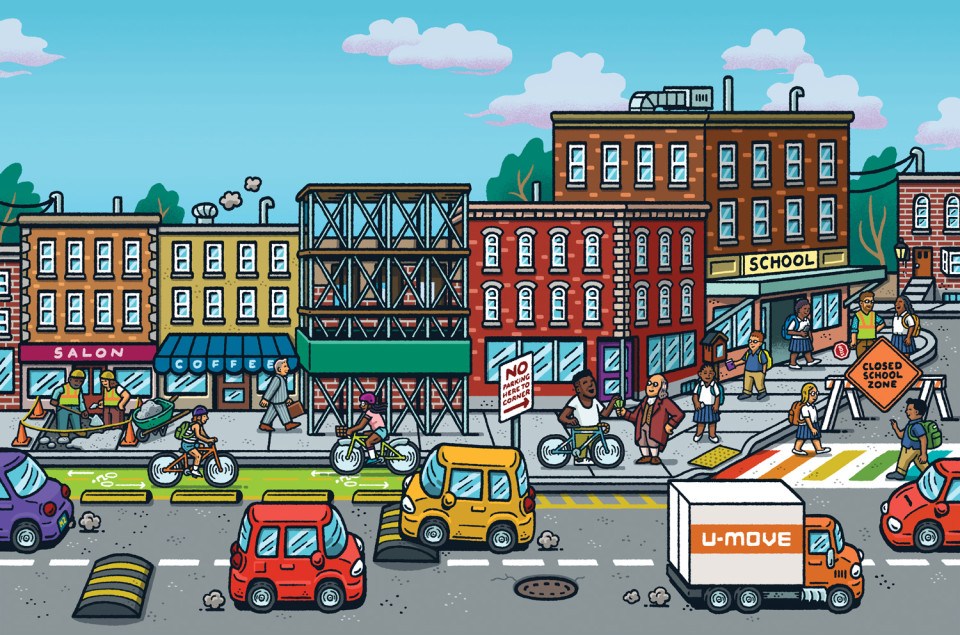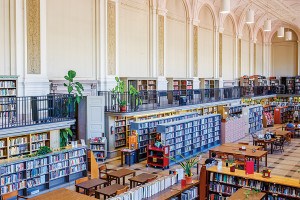8 Ways to Make Philly Streets Safer for Kids
From bike lanes to “school streets,” here are steps Philly can take to improve mobility and safety.

Seek and find! Can you spot all the ways we can make safer streets for kids in Philly? / Illustration by Mario Zucca
In the early 1970s, the people of the Netherlands had had enough: Too many fellow citizens — 3,300 a year, 500 of them children — were dying in traffic-related accidents. So they took to the streets, literally. Their Stop de Kindermoord (“Stop child murder”) movement pushed through a transportation transformation that saw traffic fatality rates go from 245 per million people to 34 per million by 2019.
In more than one way, we’d do well to channel the Dutch now in Philly, a city where so many streets feel like the Wild West — where more than 120 people died in traffic fatalities last year, and police answer 40 hit-and-run calls a day.
Of course, safe streets aren’t just for kids and the people who are raising them. But there’s wisdom in considering mobility from a child’s perspective, says Andrew Stober. He spent years running Philly’s Department of Transportation and Utilities, and he’s currently in the private sector, working on transportation with cities around the world. He points to the mobility-focused 8 80 Cities Initiative, which operates on the premise that a city planned for eight-year-olds and 80-year-olds will be the best city for all people — more inclusive, more equitable, safer, more active. And not for nothing, Stober adds, Philly’s population of 80-year-olds with similar mobility needs to those of children and families is going to grow substantially in coming decades.
So … what might better look like for us? A few ideas:
Sidewalks
In Philly, sidewalk upkeep — which ain’t cheap — is the responsibility of the adjacent property owners. There’s an equity issue at play here, as Stober points out — but we could make, ahem, inroads if the city committed a million bucks a year for 10 years to repair sidewalks in the neighborhoods where homeowners can least afford it.
Scaffolding & Construction Walkways
“In New York,” one South Philly parent recently noted, “there’s construction all the time, but there’s scaffolding, so you can still use the sidewalks.” Not so in Philly, where obstructions frequently inconvenience and endanger pedestrians despite campaign promises, Council bills, and enticements to developers. But hey, where there’s (political) will, there’s a way — and we’ve got a raft of new electeds coming into office.
Brighter Crosswalks
Painting crosswalks in bright colors and designs, à la our own Gayborhood crossings, has been shown to reduce crashes involving pedestrians and cyclists, per one Bloomberg Philanthropy study that also found “asphalt art” led to a 27 percent increase in drivers yielding to walkers. But as Stober notes, even just regular black-and-white restriping near parks, schools and rec centers would help.
Protected Bike Lanes
We’re beginning to see more, little by little. The newest ones are planned for Old City. Can’t happen fast enough.
Money to Bike
When Denver launched an e-bike rebate program, the city saw 20 times the interest it had planned for, helped move some 5,000 bikes, and cut an estimated 2,040 metric tons of carbon dioxide. Cleaner air, less car traffic, affordable transportation: Get after it, Philly.
School Streets
In London, in Paris, in Vancouver, streets around schools are closed to traffic, either permanently or during the hours when kids come and go. “This is the thing I’d love to see the most,” says Diana Lind, an urban policy specialist. “It’s easier for kids to walk or bike to school; they have more places to play; you could even turn some of these into garden streets.” It’s worth piloting, she says, to see how the idea is received by each school community.
No Parking
Parked cars at intersections make visibility almost impossible — but enforcement of no-parking signs, Stober says, is expensive and disproportionately impacts lower-income car owners. Instead? “Put in some basic infrastructure — flexible bollards or curb bump-outs made with paint — that are a clear deterrent to parking,” he says. People will gripe about lost spaces, sure. “But you say, ‘This is to benefit you, so people who aren’t from your neighborhood aren’t parking here and making it unsafe for you,’” Stober says. “That’s how you sell it.”
Neighborhood Input
Most neighborhood residents can tell you exactly where the most dangerous spots are — where people speed, where they blow through stop signs. Alas, the city doesn’t always have the data to prove it, which can thwart neighbors trying to keep their streets safe. Empowering citizens via petitions that readily allow for low-cost pilots — things like temporary speed humps and simple barricades to serve as traffic-calming bump-outs — would engage more of us in public safety … and possibly save lives.
>> Click here for 17 Big Ideas to Make Philly a Kid-Friendly City
Published as “Make our Streets Safer” in the July 2023 issue of Philadelphia magazine.


